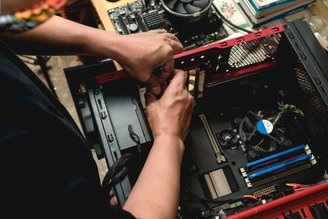If you’re on a mission to buy a new laptop or upgrade your PC, you’ll likely come across the option of a processor with integrated graphics at some point in your search.
Technology It combines the CPU (main processor) and GPU (graphics card) into a single component, It attracts attention due to its practicality and cost advantage. Models such as the Intel Core i5-11600K and AMD Ryzen 7 5700G are notable examples of this category.
So, is integrated graphics the ideal choice for your usage profile? Correct answer: Depends on your knowledge of the topic!
Do you know what the differences are between this type of GPU and dedicated GPUs? So what are the advantages and disadvantages of a processor with integrated graphics?
We’ve put together all the information you need to find which solution is best for you! Shall we go?
What is a processor with integrated graphics?
Processor with integrated graphics, known as APU (Accelerated Processing Unit) in AMD products or iGPU (Integrated Graphics Processing Unit) in common terminology, such a technology combines two key components For the computer to work:
Unlike dedicated video cards that have their own memory, integrated video cards use some of the system’s RAM memory to process and store graphics data.
This combination occurs on a single silicon chip. offers greater integration and energy efficiency For those who perform daily tasks and need moderate graphics performance.
Although it facilitates communication between the CPU and GPU via fast data paths, sharing the memory controller can impact overall system performance, especially in resource-intensive activities.
Figuring out if your device has an integrated graphics card is simple: just access “Device Manager” in Windows and check the video adapters listed. If there is only one device listed, it is probably integrated with the processor.
What are the differences between the processor with integrated graphics and the traditional version?
A traditional processor (without an integrated GPU) focuses only on processing general calculations and leaves the handling of graphics to an external (dedicated) video card, which has its own dedicated memory (VRAM) and graphics processing unit.
This is ideal for those who use their computers for graphics-intensive activities such as 3D modelling, advanced design or high-end gaming.
In addition, it does not depend on the system’s RAM memory, dedicated cards can maintain more consistent performance.
Processors with integrated graphics cards, also called onboard video cards, combine the CPU and GPU into a single chip, optimizing space and costs, but with some limitations.
The integrated graphics card is built directly into the processor or motherboard and uses system resources such as RAM to perform graphics tasks.
Is it better to buy the processor with the video card or both separately?
Choose between a processor with integrated graphics or invest in a dedicated GPU and a traditional processor depends on the type of planned use to the computer.
For everyday tasks like surfing the web, using lightweight Office suite programs, or watching 4K video, integrated graphics cards are more than enough.
These chips are capable of powering even high-resolution monitors, offering good performance without overloading the system.

On the other hand, if the goal is to play games, edit high-resolution videos or work with 3D modelling, it is ideal to choose a dedicated graphics card.
As we have seen, GPUs offer their own video memory (VRAM); Superior performance in more graphic-intensive activitieswithout compromising the computer’s RAM memory.
However, this extra power comes with challenges such as higher power consumption, heat generation, and higher cost due to the need for specialized cooling systems.
Careful planning is important when choosing a custom card. Rapid technological evolution could make the cutting-edge GPU obsolete in just a few yearsespecially if new graphical demands arise.
So careful consideration of expected usage and available budget will help you decide whether a processor with integrated graphics is sufficient or whether it’s worth investing in separate hardware components.
What are the advantages and disadvantages of a processor with integrated graphics?
Processors with integrated graphics offer a number of advantages and disadvantages that make them suitable for different user profiles. Its design offers the following positive and negative points:
Advantages
- Space and energy saving: Since it takes up less space, it produces less heat and consumes less energy, making it ideal for thin and light laptops. This contributes to longer battery life;
- Cost-benefit: PCs with integrated graphics are generally more affordable, making them an attractive option for users on a budget;
- Reliable basic performance: They are enough for everyday tasks like surfing the internet, editing documents, playing high-resolution videos, and even light gaming.
Disadvantages
- Lower graphics performance: Compared to dedicated cards, they have less processing power, which limits their capacity for advanced games and demanding graphics software;
- Shared memory usage: This can affect the overall performance of the computer, especially when multitasking;
- Lack of advanced features: Technologies like ray tracing and DLSS, available on dedicated GPUs, is not available on integrated graphics;
- Unable to upgrade: Because they are built into the processor, they cannot be replaced or upgraded separately.
After all, is it worth investing in an integrated graphics card?
Deciding whether to invest in a processor with integrated graphics or a dedicated graphics card depends mainly on your needs and expectations regarding computing.
For many users, Integrated GPU is a practical and economical solutionperforms daily tasks well.
If you plan to browse the web, use office applications, watch high-resolution videos, or do light photo editing, an integrated card like Intel Iris Xe Graphics can provide adequate performance.
Additionally, integrated GPUs consume less power, produce less heat, and do not require complex ventilation systems; This makes them ideal for those looking for a portable device.

On the other hand, if your activities involve 3D imaging, modern gaming, or intensive video editing, dedicated graphics cards are the best option.
They offer superior graphics performance, have their own memory, and do not compromise the system’s RAM. However, they require more investment, consume more energy, and may require more robust cooling systems.
One An interesting alternative for those looking for flexibility are hybrid systemswhich combines integrated and dedicated GPUs and switches between them based on demand. This ensures efficiency for simple tasks and high performance for more demanding activities.
In short, if you need a computer for basic tasks and want to save money, it’s worth investing in a processor with integrated graphics!
However, before giving the final word, always make the best decision by evaluating your budget, system features and usage pattern.
So, did you like today’s tips? Keep browsing TecMundo and also check out the benefits of Intel Core Ultra. new processor series Intel Core i3 aims to replace Core i5 and Core i7. Until next time!
Source: Tec Mundo
I am a passionate and hardworking journalist with an eye for detail. I specialize in the field of news reporting, and have been writing for Gadget Onus, a renowned online news site, since 2019. As the author of their Hot News section, I’m proud to be at the forefront of today’s headlines and current affairs.










